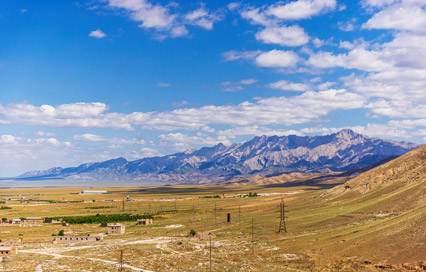Geography of Uzbekistan - Discover A Land of Contrasts and Beauty
October 28, 2024
The geography of Uzbekistan is an enthralling fusion of varied topography and cultural value. This country, which is in Central Asia, has defined its history and cultural identity largely through its geographic location.
Nestled in the center of the continent, the vast steppes of Uzbekistan, the breathtaking Nuratau-Kyzylkum biosphere reserve, and the lush Fergana Valley are sure to entice nature lovers. Travelers looking for an unforgettable experience will find that Uzbekistan's diverse landscapes and rich past provide a remarkable voyage, from discovering the cultural tapestry of Tashkent to touring the ancient cities of Samarkand and Bukhara, which bore witness to millennia of history.
Now, we will discover the geography of Uzbekistan in order to see the nation’s wonders of nature, rich desert, riparian woodlands to mountainous mountains.
Related Articles:
- Where Is Uzbekistan Travel Guide To Central Asias Hidden Gem
- Cities To Visit In Uzbekistan Exploring The Best Destinations
- Best Places To Visit In Tashkent Discover Uzbekistans Hidden Gems
- Tashkent Sightseeing Places A Complete Guide For International Visitors
- Unmissable Things To Do In Samarkand The Heart Of The Silk Road
- Samarkand Day Trip
Status of Geography of Uzbekistan
Uzbekistan is rich in natural resources, particularly natural gas, oil, gold, and uranium. The country ranks among the top producers of gold in the world, and its mineral wealth has played a key role in its economic development. Natural gas is another important resource, with Uzbekistan being one of the largest producers in the region. Much of the country’s energy needs are met through domestic gas production, and Uzbekistan also exports gas to neighboring countries.
Agriculture is another cornerstone of the economy, with cotton being the most important crop. Known as “white gold,” cotton has been central to Uzbekistan’s economy since Soviet times, although its production has come under scrutiny for its impact on water resources and labor practices. In recent years, the government has sought to diversify agricultural production, encouraging the cultivation of fruits, vegetables, and other cash crops to reduce dependence on cotton.
Major Geographic Regions in Uzbekistan
Covering an area of 448,978 square kilometers, Uzbekistan shares borders with Kazakhstan to the north, Kyrgyzstan to the northeast, Tajikistan to the southeast, Afghanistan to the south, and Turkmenistan to the southwest.
Uzbekistan can be divided into three major geographic regions: the deserts, the mountains, and the river valleys. Each of these regions has its own unique characteristics and influences the lives of the people who inhabit them.
Deserts: The Kyzylkum and Karakum
A significant portion of the geography of Uzbekistan is dominated by arid desert landscapes, most notably the Kyzylkum Desert, which occupies a large part of the central and northern regions of the country. The name "Kyzylkum" means "Red Sands" in Turkic, a fitting description for this vast and desolate area. The Kyzylkum Desert is the 15th largest desert in the world, and its shifting sand dunes stretch across an area of around 300,000 square kilometers, overlapping into neighboring Kazakhstan and Turkmenistan.
In the Uzbekistan geography map, to the west lies the Karakum Desert, which is mostly located in Turkmenistan but extends into southwestern Uzbekistan. Both deserts are characterized by extreme temperatures, with scorching hot summers and cold winters. Despite the harsh conditions, these deserts have been home to nomadic tribes for centuries. The people here have adapted to the environment, relying on camels and desert flora for sustenance.

Uzbekistan desert landscape
Mountains: The Tien Shan and Pamir-Alay Ranges
In stark contrast to the flat deserts, the eastern and southeastern parts of Uzbekistan are dominated by mountain ranges that provide a cooler and more hospitable environment. The two primary mountain ranges are the Tien Shan and the Pamir-Alay.
The Tien Shan range, meaning "Celestial Mountains," stretches across the northeastern border with Kyrgyzstan and Kazakhstan. These mountains are known for their rugged beauty, snow-capped peaks, and lush alpine valleys. Uzbekistan’s highest peak, Khazret Sultan (4,643 meters), is located in this range. The Tien Shan mountains are home to several national parks and nature reserves that protect endangered species and offer a popular destination for trekkers and adventurers.
The Pamir-Alay range, situated in the southeastern part of the country near Tajikistan, is another impressive mountainous region. This area is more remote and less developed compared to the Tien Shan, but it is equally striking with its deep gorges, steep cliffs, and high-altitude plateaus. The mountains in this range are dotted with villages that have preserved traditional lifestyles for centuries.

Pamir-Alay Mountain ranges in Uzbekistan
River Valleys: The Amu Darya and Syr Darya
Geography of Uzbekistan’s rivers are the lifeblood of its agricultural industry, and the two most important rivers are the Amu Darya and the Syr Darya. Both rivers originate in the mountains of neighboring countries and flow across the plains of Uzbekistan before emptying into the Aral Sea, or what remains of it.
The Amu Darya, known as the Oxus in ancient times, is one of Central Asia’s major rivers, stretching over 2,400 kilometers. It flows from the Pamir Mountains and serves as the natural border between Uzbekistan and Turkmenistan for much of its course. The Syr Darya, slightly shorter at around 2,200 kilometers, begins in the Tien Shan mountains and runs through Uzbekistan before entering Kazakhstan.
The fertile river valleys created by these two rivers have supported human settlement for thousands of years. Historically, they were critical to the development of ancient civilizations, including the Achaemenid Empire and the Samanid Dynasty. Today, these rivers continue to be vital for irrigation, especially for Uzbekistan’s cotton industry, although intensive irrigation has contributed to environmental issues, such as the drying up of the Aral Sea.

Syr Darya river
Climate of Uzbekistan
The climate is predominantly continental and depending on the geography of Uzbekistan, with hot summers and cold winters. The country’s desert regions experience some of the most extreme temperatures, with summer highs often exceeding 40°C (104°F) and winter temperatures dropping below freezing. The mountain regions, however, enjoy a more moderate climate with cooler summers and heavy snowfall in winter, which helps replenish rivers and provides water for irrigation.
The spring and fall seasons are the most pleasant times of the year, with mild temperatures and clear skies, making them the best times to visit Uzbekistan. The fertile river valleys, especially in the Fergana Valley, benefit from the more temperate climate and are the agricultural heartland of the country, producing crops such as cotton, wheat, and fruits.
Conclusion
The geography of Uzbekistan is a land of contrasts, where barren deserts meet towering mountains, and ancient river valleys sustain life in one of the driest regions of the world. This unique blend of natural features has shaped the culture, economy, and history of Uzbekistan, making it a fascinating country to explore. However, challenges such as environmental degradation, particularly the loss of the Aral Sea, remind us of the delicate balance between human activity and nature in this region. As Uzbekistan continues to develop, its geography will remain both a source of wealth and a challenge to be managed carefully.
Now it’s time to apply for an Uzbekistan e-visa and visit this wonderful country. If you worry about the complicated process, the best solution is to use the e-visa system. However, travelers should check your requirements in order to know whether you are qualified or not. GVC will help you to standardize your documents and boost high visa success rates. Meanwhile, you can plan and prepare your trip to Uzbekistan easily and without difficulties. Let’s travel to Uzbekistan!
Tags




